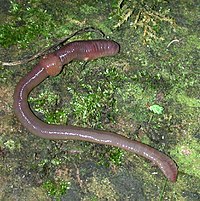Worm
This article has multiple issues. Please help improve it or discuss these issues on the talk page. (Learn how and when to remove these template messages)
No issues specified. Please specify issues, or remove this template. |
A worm is an elongated, slender, soft-bodied invertebrate animal. Invertebrates are animals that lack a backbone. Worms are so different from each other that they have not been classified under a single group. Indeed, many species are entirely unrelated to one another.
Distribution and habitat
There are at least 20,000 kinds of worms. They are found almost all over the world. Worms are universal in distribution, occurring in marine, freshwater, and terrestrial habitats. Some worms that live in the ground help to condition the soil (e.g., annelids, aschelminths). Many thrive as parasites of plants (e.g., aschelminths) and animals, including humans (e.g., platyhelminths, aschelminths). Several other worms may be free-living, or nonparasitic. There are worms that live in freshwater, seawater, and even on the seashore. Ecologically, worms form an important link in the food chains in virtually all the ecosystems of the world
Classification
In everyday language, the term worm is also applied to various other living forms such as larvae, insects, centipedes, or even some vertebrates creatures with a backbone) such as blindworms. Worms can be divided into several groups, of which three are important:
- The first of these includes the flatworms. They have a flat, ribbon- or leaf-shaped body with a pair of eyes at the front. Some are parasites.
- The second group contains the threadworms, roundworms, and hookworms. Threadworms may be microscopic, such as the vinegar eelworm, or more than 1 meter (3 feet) long. They are found in damp earth, moss, decaying substances, fresh water, or salt water. Many are parasites. Some roundworms are also parasites. The Guinea worm, for example, gets under the skin of the feet and legs of people living in tropical countries.
- The third group consists of the segmented worms, with bodies divided into segments, or rings. Among these are the earthworms and the bristle worms of the sea.
There are hundreds of thousands of species that live in a wide variety of habitats other than soil. Over time this broad definition narrowed to the modern definition, although this still includes several different animal groups. Major phyla that include worms include:

- Acanthocephala (spiny-headed worms)
- Ancylostoma (hook worms)
- Annelida (segmented worms)
- Cestoda (tapeworm)
- Chaetognatha (arrow worms)
- Ectoprocta (goblet worms)
- Gnathostomulid (jaw worms)
- Hemichordata (acorn/tongue worms)
- Kinorhyncha (spiny-crown worms)
- Nematoda (roundworms)
- Nematomorpha (horsehair worms)
- Nemertea (ribbonworms)
- Onychophora (velvet worms)
- Phoronida (horseshoe worms)
- Platyhelminthes (flatworms)
- Priapula (phallus worms)
- Sipuncula (peanut worms)
The most common worm is the earthworm, a member of phylum Annelida. Earthworms in general have been around for 120 million years, evolving during the time of the dinosaurs. They enrich and aerate the soil; Charles Darwin found that worms turn over the top six inches (15 cm) of topsoil every 20 years. One Australian species can grow to eleven feet (3 m) in length. They lack a brain but have nerve centers (called ganglia); they also lack eyes but can sense light with photoreceptors. Worms are hermaphrodites (both sexes in one animal) but can cross fertilize.
Other invertebrate groups may be called worms, especially colloquially. In particular, many unrelated insect larvae are called "worms", such as the railroad worm, woodworm, glowworm, bloodworm, or silkworm.
Worms may also be called helminths, particularly in medical terminology when referring to parasitic worms, especially the Nematoda (roundworms) and Cestoda (tapeworms). Hence "helminthology" is the study of parasitic worms. When an animal, such as a dog, is said to "have worms", it means that it is infested with parasitic worms, typically roundworms or tapeworms.
Characteristics

Worms usually have a cylindrical, flattened, or leaf-like body shape and are often without any true limbs or appendages. Instead, they may have bristles or fins that help them move. Many worms have sense organs that can detect environmental change. A few may even have light-sensing organs. Worms vary in size from less than 1 mm (0.04 inch) in certain aschelminths to more than 30 m (100 feet) in certain ribbon worms.
Some worms reproduce sexually. Hermaphroditism, the condition in which a single individual possesses both male and female reproductive parts, is common in many groups of worms. Asexual reproduction, whereby new individuals develop from the body cells of another, also occurs in some worms.
Worm species differ in their abilities to move about on their own. Many species have bodies with no major muscles, and cannot move on their own — they must be moved by forces or other animals in their environment. Many other species have bodies with major muscles and can move on their own; they are a type of muscular hydrostat. Many species of worms are decomposers; they break down dead plants and animals to return nutrients to the soil.
The word worm can also be used as a perjorative, e.g. to call somebody a worm means that the person is behaving in an obsequious, attention seeking, and to try and get sympathy in an insincere manner.
